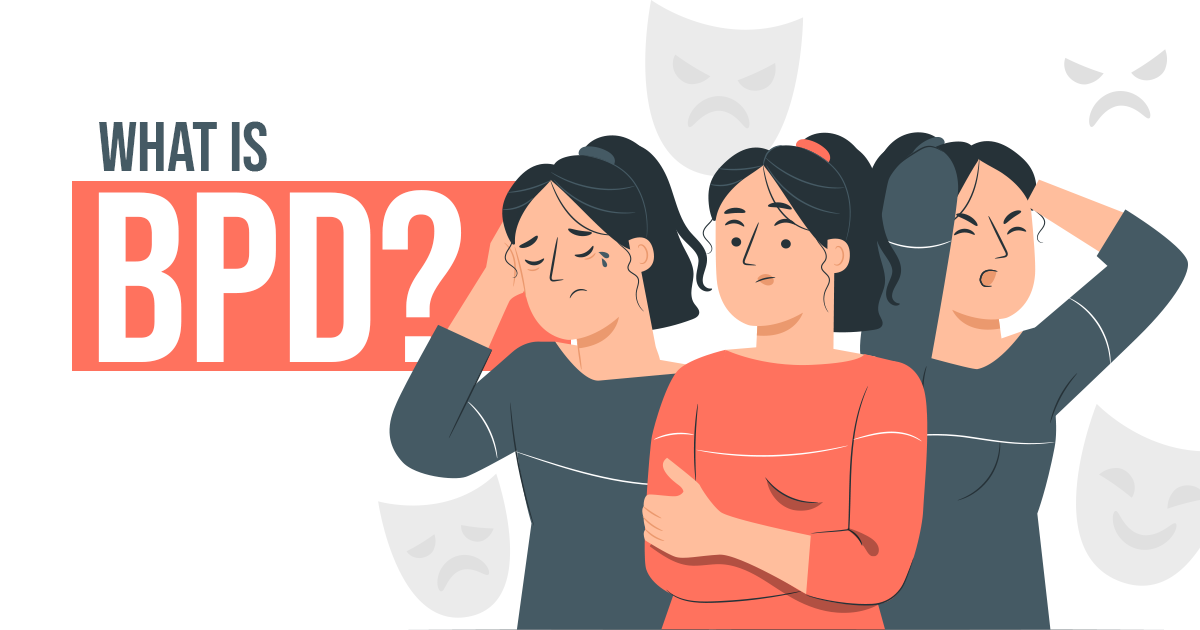BPD stands for borderline personality disorder. A personality disorder is a distortion in how someone thinks, feels, or behaves that deviates from expectations.
There are ten personality disorders. All are long-term behavioral patterns and inner experiences that differ significantly from expectations. The patterns will usually begin to develop by late adolescence or early adulthood. They can be distressing and impact function. Without treatment, these disorders may last for someone’s entire life.
Understanding Personality Disorders
A personality disorder will affect at least two of four areas. These are how someone thinks about themselves and others, their emotional response, how they relate to others, and how someone controls their behavior.
These psychiatric disorders can cause problems in relationships and functioning and can lead to distress.
- BPD affects how someone thinks and feels about themselves and others.
- When someone has BPD, it can affect their self-esteem, how they manage emotions, and their behavior, and they may have patterns of instability in relationships.
- Along with unstable relationship patterns, someone with BPD might engage in impulsive behavior that’s a risk to themselves and others.
Our personalities are how we think, feel and behave.
- They’re what set us apart from other people.
- Our personalities are influenced by environmental factors, experiences, and inherited characteristics.
- A history of sexual abuse, post-traumatic stress disorder, or other experiences can also influence the development of personality.
- Our personalities will often stay pretty stable over time.
- If someone has a disorder, their thinking, behavior, and feelings can be different than what would be culturally expected or seen as “normal.”
- These disorders are ongoing without effective treatment.
Personality disorders can be broken down into three general categories, and there is ten total, according to the American Psychiatric Association.
These include:
- Suspicious: paranoid, schizoid, schizotypal (can include psychotic symptoms)
- Emotional and impulsive: antisocial personality disorder, borderline, histrionic, narcissistic
- Anxious: avoidant, dependent, obsessive-compulsive personality disorders
Each has an individual set of diagnostic criteria. If someone meets the criteria for more than one, it’s a mixed disorder.
What Is BPD?
Back to the original question—what is BPD?
Borderline personality disorder leads someone to experience negative emotions like extreme fear of abandonment or instability, and the individual may have difficulty being alone. BPD can cause anger, mood swings, and impulsiveness, often pushing others away, despite a desire to have lasting, loving relationships.
Someone with BPD will tend to see things in extremes. They may view, for example, a romantic partner as all good or all bad. They might have values and interests that change quickly and can behave recklessly or impulsively.
Other symptoms of BPD include:
- Taking extreme efforts to avoid both real and perceived intense fear of abandonment. This can lead someone to enter relationships very quickly, and they might end them just as quickly as they begin.
- Extremes of idealization, meaning that you either worship someone or completely devalue them and can change quickly.
- Patterns of intense relationships and chaotic relationships extend not only to romantic relationships but also to those with family and friends.
- Distorted, unstable sense of identity and identity disturbances.
- Engaging in risky and dangerous behaviors like unsafe sex, reckless driving, substance abuse, or excessive spending.
- Self-injurious behavior
- Suicidal behavior, thoughts, or threats regarding the risk of suicide.
- Intense mood swings, emotion dysregulation, and emotional instability
- Feelings of emptiness
- Problems controlling anger
- Dissociative symptoms, meaning a person with BPD, might feel cut off from themselves. A person with borderline personality disorder could feel like they’re observing themselves from the outside, or they might feel like what they’re experiencing isn’t reality.
Not all people with this personality disorder will experience all of these symptoms. How severe, frequent, and long these symptoms last depend on the person.
Someone with BPD may be at higher risk of developing drug abuse or substance use disorder to self-medicate mood fluctuations, emotional dysregulation, and other symptoms in daily life that can occur with BPD.
Diagnosing Borderline Personality Disorder
It can be somewhat challenging to diagnose disorders of the personality.
- A licensed mental health professional with experience in diagnosing and the clinical management of borderline patients may be able to go through an interview with someone and talk about their symptoms.
- They will also rule out other possible reasons for symptoms. For example, many symptoms of BPD overlap with bipolar disorder, like the rapid shifts in a depressed and elevated mood.
- A mental health provider will discuss family medical history, including any familial history of mental illness.
- Most people with BPD receive a diagnosis in their late teens or early adulthood. Sometimes a person younger than 18 will be diagnosed.
- There are often other co-occurring mental health disorders that occur with BPD. These include PTSD, anxiety disorders, major depression, bipolar disorder, substance abuse, and eating disorders.
BPD Treatment in Orange County, CA
Because of how much our personalities are an engrained part of who we are, personality disorders like BPD are historically challenging to treat, but it is possible. This is especially true as we’re learning more about personality disorders.
There are newer, evidence-based treatment options so that people with BPD can experience fewer severe symptoms and fewer of them. That can improve functioning and their quality of life. The most important thing for someone with BPD is to receive a diagnosis from an experienced, licensed mental health professional.
It’s also important that once someone begins treatment for BPD, they stick with it. It can take time to start seeing the benefits of BPD treatment.
Treatment options can include:
- Psychotherapy: Also known as talk therapy, different types of psychotherapy are the first-line treatment for borderline personality disorder. You work with a trained mental healthcare provider in group or individual therapy sessions. Dialectical behavior therapy (DBT) is one psychological therapy specifically designed for people with BPD. With dialectical behavior therapy, you use mindfulness to look at your current situation and emotional state along with the help of your care team. You learn skills to help control your intense emotions, improve relationships, and reduce self-destructive behaviors. Cognitive behavioral therapy (CBT) is another type of therapy that may be used for BPD.
- Medications aren’t often used as a primary treatment for personality disorders. Still, psychiatric management might include certain medicines to help with particular symptoms or co-occurring disorders like depressive or other mood disorders. For example, some people might benefit from mood stabilizers to help with unstable moods.
- Family therapy: Borderline personality disorder can greatly impact personal relationships. Family members may inadvertently act in ways that worsen the symptoms of BPD for their loved ones. Family therapy can be a good way to help learn how to support someone with BPD and be part of an effective treatment plan led by a mental health team.
- Lifestyle changes: There are a lot of strategies someone with BPD can do on their own to help manage their symptoms. For example, mindfulness meditation, exercise, nutrition, getting enough sleep, and taking time for self-care can all be important in managing a personality disorder. Not living a healthy lifestyle can be a risk factor for worsening BPD symptoms.
Contact our Orange County team today if you’d like to learn more about mental health treatment options, including for borderline personality disorder. There are treatment options available for this and other psychiatric disorders, from helping you create coping mechanisms for interpersonal relationships to managing extremes in emotions. Call Story Wellness at (866) 476-2823 to learn more today.





